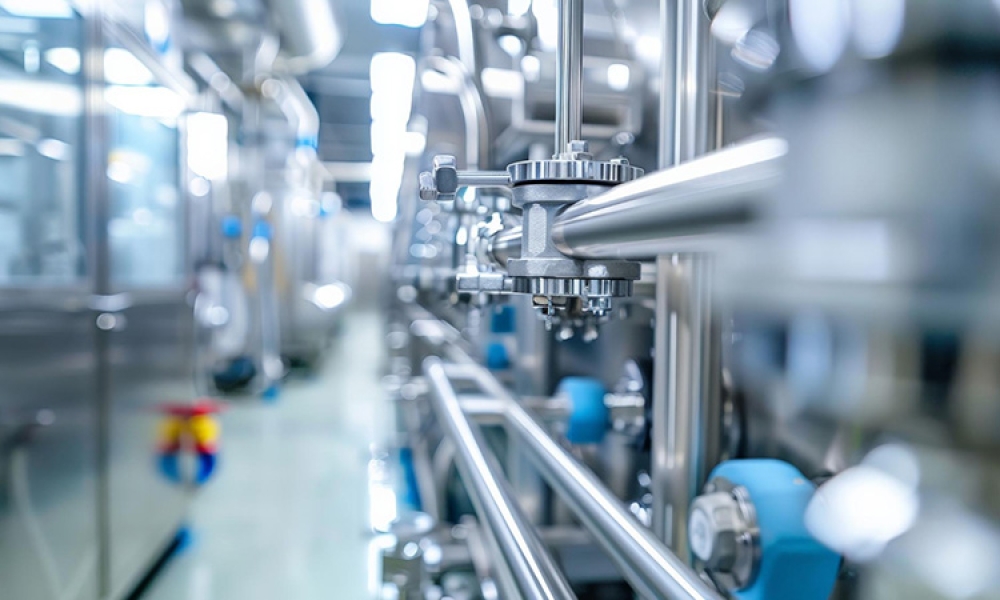ATMP Cleanroom Facilities: A Roadmap for Success

What is the Route to Successful ATMP Cleanroom Development?
Mitch Gonzales, Vice President of Process Technology and Grant Merrill, Chief Commercial Officer at AES Clean Technology, explore the unique aseptic processing needs of advanced therapy medicinal products (ATMPs) and explain the ideal pathway to successful cleanroom design for this class of therapies.
ATMPs — cell, gene, and tissue therapies — are transforming medicine. They represent a significant medical advancement based on the knowledge gained from the human genome, reflected in the growth in the ATMP market. Valued at $8.4 billion in 2022, the segment is projected to reach $20.63 billion by 2031, growing at a compound annual growth rate of 10.5% throughout the forecast period .
Still in its infancy as a therapy class, ATMPs pose unique scalability challenges for companies at the commercialization stage. A particular issue that must be addressed is the design of manufacturing facilities.
To overcome this obstacle, manufacturers have made strides over the last decade to develop new pathways to design and install cleanroom facilities that deliver the benefits of both advanced science and manual-dependent processes. These efforts offer essential lessons for best practices in ATMP cleanroom design to help manufacturers chart a route to success in the future.
Unique Manufacturing Challenges Require a Unique Design
As with other treatments, successful ATMPs generate demand that can only be sustained through scalability, from the laboratory to pilot and eventually commercial manufacturing in a current good manufacturing practice (cGMP)1 space. Early in the evolution of ATMPs, it became clear that the therapeutic class had unique commercial manufacturing and logistics needs.
ATMPs classed as autologous therapies require processes which begin and end with the patient. Once cells are extracted, the formulation process occurs in a cleanroom environment, ideally located close to the patient’s treatment center. The proximity of the cleanroom significantly reduces logistical risks, enhances quality characteristics, and improves patient treatment. The logistics challenges and manual processing involved with ATMP manufacturing drive the business toward multiple smaller-scale, repeatable facilities that are each close-coupled to significant patient populations, thereby optimizing the outcome for as many patients as possible while minimizing the risk to patient material.
Once the biologic material is separated, ATMPs have specific requirements for the regulation and design of cleanroom facilities. Most cell and gene therapy manufacturing require relatively small-scale and defined processes, which don’t require the use of the complex, high-volume facilities that are typically used in the manufacture of conventional therapeutics.
ATMPs also have complex requirements for aseptic processing compared to large batch quantities. A series of mini-environments (appropriate class BSC hood stations) requiring a Grade C or B background can be used in place of a single large Grade A space. HVAC demands are likewise simplified due to the reduction in Grade A footprint. Still, the control and performance are no less rigorous because the background environment must be compliant in supporting aseptic processing. Segregation between workstation areas is critical to avoid cross-contamination. Airflow distribution must not only meet temperature, humidity, cleanliness, and pressurization standards, but segregation of air flows must also support case separation.
Single-use technologies (SUT) have also become widely accepted in ATMP production due to their ability to streamline cleaning and changeover processes while maintaining optimum sterile conditions. This helps to overcome some of the issues posed by creating processing infrastructure for small-volume production. Therefore, any cleanroom infrastructure implemented for ATMP manufacturing should be compatible with SUT equipment.
Approaches to Scalable Cleanroom Design
Currently, there are three main approaches to designing and installing cleanrooms for ATMPs:
- Traditional stick-built drywall-based facilities: This form of construction has perceived short-term advantages of material and labor availability. However, it poses challenges when increased capacity is needed later. Stick-built cleanroom facilities use outdated construction materials, such as gypsum-based drywall, which can absorb moisture. This can promote mold growth, undermining sterility. They are also high-maintenance and lack adaptability to meet stringent cleanliness standards and low particulate count, leading to operational disruption when commercial supply is critical.
- Pre-manufactured container-style cleanrooms: These streamline the design and installation of a cleanroom compared with the traditional stick-built drywall-based facilities approach. However, they struggle with integration in many host-building scenarios due to the nature of their fixed boundaries. Also, once installed, their design lacks flexibility, limiting process expansion to meet changing output needs.
- Modular cleanroom installation: Modular cleanrooms involve pre-manufactured systems, including architectural and mechanical infrastructure built to exacting specifications and made of fit-for-purpose inorganic materials that don’t promote microbial growth. These cleanroom facilities are all coated in a uPVC layer capable of withstanding harsh cleaning regimes with minimal maintenance. The prefabricated cleanroom components receive verified process quality control checks during manufacture before reaching the installation site, streamlining the integration process. In most instances, modular cleanrooms can easily be expanded, sometimes in the space of a shutdown or long weekend, with minimal operational disruption. They can be fitted into any host building environment. Also, unlike stick-built construction, which contributes substantial airborne contamination, modular installation is performed under cleaner conditions without any airborne particle-generating burden that can occur with traditional organic building materials. One disadvantage of this approach is it can be cost prohibitive, especially for smaller therapeutic companies.
A Roadmap to Successful ATMP Cleanroom Design
There are clear advantages and disadvantages for each type of cleanroom design for developing aseptic infrastructure for the new generation of ATMPs.
However, even with the various designs and installation methods in mind, companies must lay the groundwork to make sure the new cleanroom meets the present and future needs of their therapy.
Cleanroom installation projects for new ATMPs over the last decade have demonstrated that commercialization success centers on a handful of capital project planning inputs. Following these as an itinerary from project beginning to completion can help ensure that the new space is delivered to the right standard:
1. Develop a production plan.
Begin with a top-down assessment of the needs of the ATMP, starting with a commercial forecast for finished goods demand. This should include projections and considerations for commercial products, clinical supplies, marketing samples, raw materials, process yields, quality control samples, FDA retains, stability, revalidations, expiration dating, overages, and warehouse and pharmacy storage capacities.
It’s also important to consider risk management and contingency factors to maintain supply continuity, which should include ongoing pipeline clinical studies. This can be a challenging task for new clinical projects, but there are expert firms that can provide these outputs on a developer’s behalf.
When a therapy goes into commercial production, a higher standard of cGMP is required, including localized protection, product traceability, and cross-contamination controls. This needs to be considered when planning for cleanroom space to ensure it is easily scaled from clinical to commercial manufacturing.
2. Confirm whether you are “making” or “buying.”
A second highly consequential success factor is a company’s decision to manufacture internally (“make”) or to outsource to a partner (“buy”). Outsourcing to a contract manufacturer offers the benefit of streamlining the journey of a new treatment to commercial production. However, the complexity of the science and manufacturing behind many ATMP products, combined with a greater need to protect intellectual property, are incentivizing a growing number of developers to “make” their therapies in-house.
The smaller batch sizes inherent to ATMPs can make it easier for developers to decide to manufacture themselves — small batch sizes require smaller manufacturing footprints, which decreases capital costs.
With this in mind, making versus buying is a serious consideration for ATMPs, and should be evaluated early in phase 3. A “bridging” strategy — where a new product is launched from a contract manufacturer before being transferred to a self-owned facility — might be appropriate in some situations. This would allow rapid commercialization and give time for the developer to finalize its infrastructure.
Completing a preliminary concept design of a new production facility in this situation is vital. It will ensure the team fully understands the manufacturing process and project scope, will confirm the best regulatory filing and quality strategy, and will help provide an actionable capital project plan for executive review.
3. Define/document the manufacturing process.
The process design has the greatest impact on the design and cost of a new cleanroom. A process flow diagram (PFD) can support the creation of fit-for-purpose design objectives. Integrating SUT into the design can help effectively “close” processes while also streamlining potential downtime from washdown regimes. The result will be a simplified facility design, reduced square footage, increased flexibility, and enhanced product transferability, all while maintaining optimum regulatory compliance. A well-documented PFD can help meet clinical, commercial and development product needs based on a necessary capital budget estimate.
4. Build cross-functional teams.
Any large strategic capital investment will encounter challenges and face risks along the way. Effective governance is vital to ensure successful project completion. A cross-functional team of the company’s subject matter experts is best placed to provide this governance due to their understanding of the operational, technical, and strategic objectives of a new ATMP.
Such a team should include members from manufacturing, development, QA/QC, regulatory, and sales and marketing. Engaging consultants can be effective in bridging any experience gaps that may exist to ensure the team has the experience to complete tasks effectively.
5. Consider the host facility.
Finally, it is important to factor the space that will ultimately host the GMP cleanroom into the project strategy. The cleanroom facility must be properly laid out within the host building project’s strategy to meet cGMP requirements for the flow of materials and personnel. At the same time, the facility must also be able to accommodate an expansion of the cGMP area in anticipation of future growth. That expansion must be able to be performed while keeping the original facility in operation with no negative impacts.
The Future is Bright for ATMPs
The rise of ATMPs represents a potential revolution in the treatment options that healthcare providers can offer patients. However, it can’t transform people’s lives for the better if companies can’t access and install the needed cleanroom space to commercialize them effectively.
Substantial changes in the way cleanrooms are designed, fitted and expanded, as well as manufacturing processes, are helping to make aseptic infrastructure more accessible for companies, provided they make the right decisions at the outset of production planning.
New strategies, from location selection to process automation, need to be harnessed as early as possible in the ideation and marketing planning stages of ATMP development.
Disclaimer:
iSpeak Blog posts provide an opportunity for the dissemination of ideas and opinions on topics impacting the pharmaceutical industry. Ideas and opinions expressed in iSpeak Blog posts are those of the author(s) and publication thereof does not imply endorsement by ISPE.




